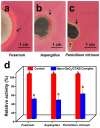Antimicrobial Activity of Nano-GeO2/CTAB Complex Against Fungi and Bacteria Isolated from Paper
- PMID: 39769304
- PMCID: PMC11676970
- DOI: 10.3390/ijms252413541
Antimicrobial Activity of Nano-GeO2/CTAB Complex Against Fungi and Bacteria Isolated from Paper
Abstract
Microbial attack, particularly fungal degradation of cellulose, is a leading cause of paper damage. To address fungal spores and the rising concern of microbial drug resistance, a nano-Germanium dioxide (GeO2)/cetyltrimethylammonium bromide (CTAB) complex (nano-GeO2/CTAB complex) with potent antibacterial properties was synthesized. Its inhibitory effects were evaluated against bacteria, including Gram-positive Staphylococcus aureus and Gram-negative Escherichia coli, as well as fungi isolated from paper (Fusarium spp., Aspergillus spp., and Penicillium citrinum). The nano-GeO2/CTAB complex exhibited significant (p < 0.05) inhibitory effects against S. aureus and E. coli. Moreover, a 60 min treatment with 1 mg/mL of the complex significantly inhibited the growth of all tested fungi and reduced their biomass after five days of culture, while 4 mg/mL completely deactivated spores. Filter paper pre-treated with the nano-GeO2/CTAB complex showed complete resistance to microbial attack, exhibiting no fungal growth and a clear inhibition zone devoid of bacterial growth. In contrast, untreated controls displayed fungal coverage exceeding 95% within five days. These findings highlight the nano-GeO2/CTAB complex as a promising antimicrobial agent for protecting paper materials from microbial degradation.
Keywords: antibacterial; antifungal; nano-GeO2/CTAB complex; paper protection; spore germination.
Conflict of interest statement
The authors declare no conflicts of interest.
Figures







Similar articles
-
In Situ Antimicrobial Properties of Sabinene Hydrate, a Secondary Plant Metabolite.Molecules. 2024 Sep 7;29(17):4252. doi: 10.3390/molecules29174252. Molecules. 2024. PMID: 39275100 Free PMC article.
-
Janus silver mesoporous silica nanobullets with synergistic antibacterial functions.Colloids Surf B Biointerfaces. 2017 Sep 1;157:199-206. doi: 10.1016/j.colsurfb.2017.05.079. Epub 2017 Jun 4. Colloids Surf B Biointerfaces. 2017. PMID: 28595136
-
Antibacterial and antifungal action of CTAB-containing silica nanoparticles against human pathogens.Int J Pharm. 2023 Jun 25;641:123074. doi: 10.1016/j.ijpharm.2023.123074. Epub 2023 May 23. Int J Pharm. 2023. PMID: 37230370
-
Dual functionality of chitosan and CTAB doped SnSe nanostructures: RhB decolorization, oxygen evolution reaction and antimicrobial activity against S. aureus by inhibiting DNA gyrase through molecular docking.Int J Biol Macromol. 2025 Apr;301:140433. doi: 10.1016/j.ijbiomac.2025.140433. Epub 2025 Jan 29. Int J Biol Macromol. 2025. PMID: 39889992
-
Hybrid combinations containing natural products and antimicrobial drugs that interfere with bacterial and fungal biofilms.Phytomedicine. 2017 Dec 15;37:14-26. doi: 10.1016/j.phymed.2017.10.021. Epub 2017 Nov 23. Phytomedicine. 2017. PMID: 29174600 Review.
References
-
- Beluns S., Platnieks O., Gaidukovs S., Starkova O., Sabalina A., Grase L., Thakur V.K., Gaidukova G. Lignin and Xylan as Interface Engineering Additives for Improved Environmental Durability of Sustainable Cellulose Nanopapers. Int. J. Mol. Sci. 2021;22:12939. doi: 10.3390/ijms222312939. - DOI - PMC - PubMed
-
- Zhao J.C., Zhang M.L., Wang S.N., Cui Z.J., Dai Z.Y., He H.Y., Qin S.T., Mei S.L., Zhang W.L., Guo R.Q. Efficient Protection of Paper-Based Cultural Relics via In Situ Synthesis of Carbon Dots/Layered Double Hydroxide. Adv. Funct. Mater. 2024;34:2401067. doi: 10.1002/adfm.202401067. - DOI
-
- Luo Z.W., Dong K., Guo M.L., Lian Z.Y., Zhang B.H., Wei W.J. Preparation of Zinc Oxide Nanoparticles-Based Starch Paste and its Antifungal Performance as a Paper Adhesive. Starch-Starke. 2018;70:1700211. doi: 10.1002/star.201700211. - DOI
MeSH terms
Substances
LinkOut - more resources
Full Text Sources
Medical
Molecular Biology Databases
Miscellaneous

